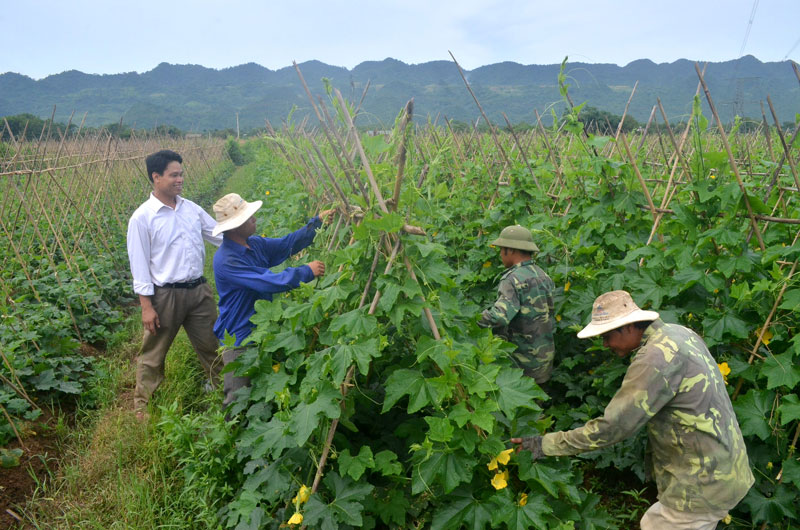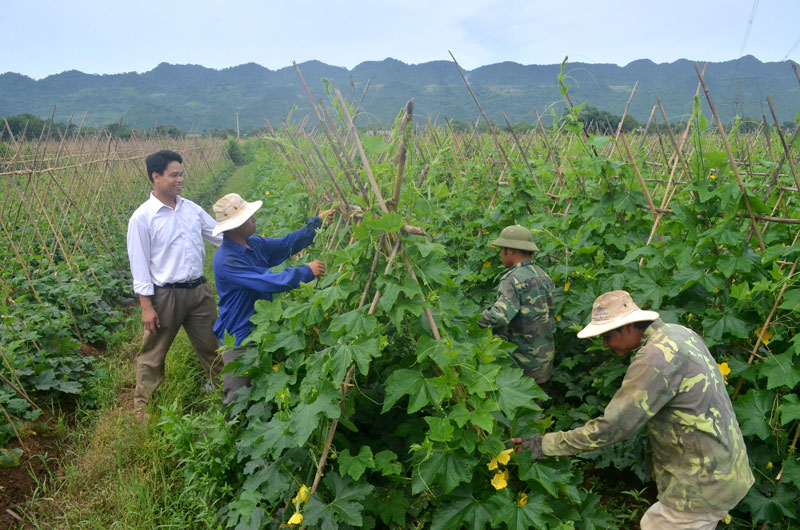
(HBO) – The northern province of Hoa Binh has taken firm steps in reforming its agricultural sector. Outstanding outcomes in the work included defining clear orientations and choosing suitable key plants and animals in service of making a breakthrough development of the sector in following years.

Photo: Locals in Nai village, Tan My commune, Lac Son
district successfully switch farming rice to water melons for higher
productivity.
The
agricultural sector has focused on applying measures to expand production of
products with higher productivity, and quality and value. The majority of
targets in agricultural restructuring have been completed.
Specifically,
the GRDP of the sector reached 4.37 percent in 2013 and 4.7 percent in 2016.
The productivity value of the sector reached 90.3 million VND per hectare in
2013 and 112 million VND per hectare in 2016. Value of each hectare of aquatic
farm hit 80.8 million VND in 2013 and 123 million VND in 2016. The ratio of locals
accessing clean water was 78 percent in 2013 and 88 percent in 2016.
At the
same time, many important policies for the sector have been designed in recent
years.
In
2014, the provincial Party Committee issued four resolutions, including those on
developing some major farm products, traditional trades, and trade villages,
increasing the breeding of fish in
Hoa
Binh
Lakein the 2014-2020 period, and supporting the sale of agricultural products.
The
provincial Party Committee also directed the realisation of measures to
implement the Party Central Committee’s resolution on agriculture, farmers and
rural areas.
In three
years from 2014-2016, the province raised awareness of local officials in
developing advantageous products of each region. Localities have selected
regions to develop their advantageous products, including the orange growing region
in Cao Phong, Lac Thuy and Kim Boi, the green-skin grapefruit growing area in
Tan Lac, the Dien grapefruit region in Yen Thuy, and Luong Son, an area growing
chayote vegetables in Tan Lac, Mau Chau, an area cultivating purple pepper in
Mai Chau, and an area planting organic vegetables in Luong Son.
The
regions showed outstanding economic efficiency, contributing to raising the
value of the cultivation sector. In
2014, the growth of cultivation was about 1.9 percent. The figure rose to 3.82
percent in 2016. The production value of the sector reached over 120 million VND
per hectare each year and even 500 million VND per hectare per year for citrus
fruits farms, and 250 million VND per hectare per year for vegetable farms.
This
is an important progress of the sector, showing steady steps forward of the
cultivation sector in the path of completing the set targets during the reform
process./.
According to data from the Hoa Binh Provincial Party Committee, the industrial production index for the first six months of 2025 is estimated to have increased by 20% compared to the same period last year. This marks the highest year-on-year growth rate for this period since 2020.
In the first six months of 2025, Hoa Binh province’s export turnover was estimated at 1.145 billion USD, marking an 18.11% increase compared to the same period in 2024. Import turnover was estimated at $ 804 million, a 17.15% increase, which helped the province maintain a positive trade balance.
The lives of the ethnic minority farmers in Tan Lac district have gradually improved thanks to the new directions in agricultural production. This is a testament to the collective strength fostered through the professional associations and groups implemented by various levels of the district’s Farmers’ Union.
With the motto the "product quality comes first,” after nearly one year of establishment and operation, Muong village’s Clean Food Agricultural and Commercial Cooperative, located in Cau Hamlet, Hung Son Commune (Kim Boi district), has launched reputable, high-quality agricultural products to the market that are well-received by consumers. The products such as Muong village’s pork sausage, salt-cured chicken, and salt-cured pork hocks have gradually carved out a place in the market and they are on the path to obtaining the OCOP certification.
In the past, the phrase "bumper harvest, rock-bottom prices" was a familiar refrain for Vietnamese farmers engaged in fragmented, small-scale agriculture. But today, a new spirit is emerging across rural areas of Hoa Binh province - one of collaboration, organisation, and collective economic models that provide a stable foundation for production.
Maintaining growing area codes and packing facility codes in accordance with regulations is a mandatory requirement for agricultural products to be eligible for export. Recently, the Department of Agriculture and Environment of Hoa Binh province has intensified technical supervision of designated farming areas and packing facilities to safeguard the "green passport" that enables its products to access international markets.



